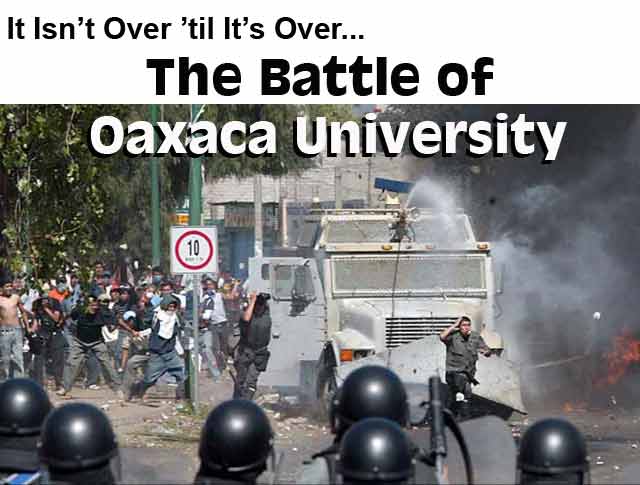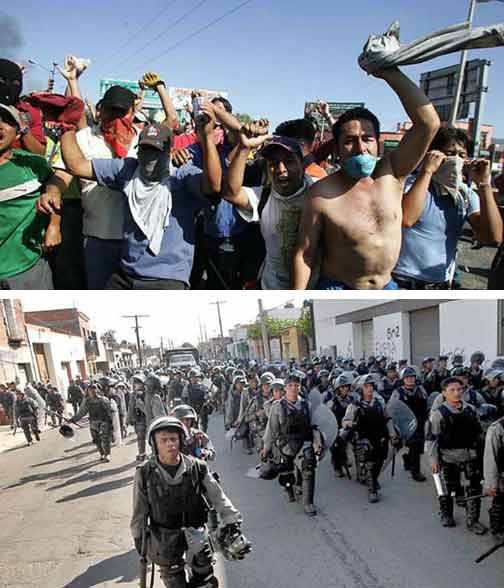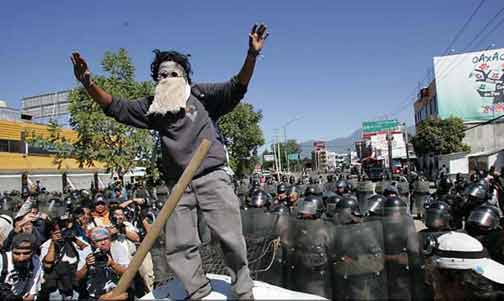
November 2006

Federal police flee from their tanqueta (armored personnel carrier) torched by militant defenders of
Oaxaca University, November 2. (Photo: Israel Rosas/Reforma)
For more than five months, Vicente Fox bet on
wearing
down the movement in Oaxaca, but without success. Now repression by
intimidation
has also backfired. A few short weeks before the December
1 inauguration of the PAN (National Action Party)
candidate Felipe Calderón, declared “president elect” by the
Supreme Electoral
Tribunal, and under the international impact of the assassination of
U.S.
journalist-activist Brad Will, time is running out for the government
of
Vicente Fox. Despite the earlier declaration by his secretary of the
interior
(Gobernación), the clerical-reactionary Carlos Abascal, that “in
the name of
god, we will not carry out any repression,” the government has
dispatched thousands
of assault troops to Oaxaca.
The
president who began his six-year term saying he would resolve the
conflict in
Chiapas (with the Zapatista National Liberation Army, EZLN) “in 15
minutes,”
now pretends in his imaginary fairy-tale country, Foxilandia, that his
occupation of Oaxaca has reestablished “order, peace and tranquility.”
Oaxacans, who shout in fury while mourning the latest of their 17 dead,
know
well that the supposed “saldo blanco” (zero casualties) reported
by the
government is a lie. The body of Jorge Alberto Beltrán, a nurse
in the Mexican
Institute of Social Security, killed by the impact of a gas grenade, is
there
to prove it.
From
the moment they entered Oaxaca city at midday on October 29, the troops
of the
Preventive Federal Police (PFP) – many of whom are from the army’s
Third
Brigade of Military Police, masquerading as “Federal Support Forces” –
have
been confronted and surrounded by the working people of the city. Whole
families came out to the highway with signs declaring, “Oaxaca no es
cuartel, fuera ejército de él” (Oaxaca is not a
barracks, Army get out).
Housewives confronted police outfitted as robocops with their
gas masks,
asking them why they repress the people. When a bus full of PFP cops
stopped,
neighbors punctured the tires, obliging the police to get off the bus,
and
later forcing them to retreat.
When
the “Cobra” armored personnel carriers known as tanquetas went
into
action, shooting out a high-pressure stream of water mixed with a
chemical
irritant in order to disperse crowds, residents retreated a few paces,
but then
went back into the street. It is interesting how this weapon, conceived
of as a
means of marking participants in “riots” with indelible ink for later
identification, is rendered useless when used against an entire
population in
revolt. After a seesaw confrontation lasting for several hours, the
troops
managed to take control of the city’s central square, the Zócalo.
The
next day, some 10,000 Oaxacans marched through the streets of their
capital
occupied by the thugs in gray uniforms, defying the tanquetas mounted
with water cannon and refusing to be intimidated by the noise of police
riot
clubs banging against their shields. Spokesmen for the federal
Secretariat of
Public Security claimed to have dismantled “more than 50” barricades
out of the
over 3,000 in the city. So now the encampment of the striking teachers
has been
replaced by a military camp, surrounded by barbed wire.
Referring
to the “recovery” of the central plaza by the paramilitary police, a
man told W
Radio: “They managed to install themselves in the Zócalo. Let’s
see how they
get out.” Indeed, the supporters of the Popular Assembly of the Peoples
of
Oaxaca (APPO), after pulling back step by step as the police troops
advanced,
have raised new barricades around the PFP, which is now trapped in the
center
of the city. Businessmen in the historical center are complaining that
the
military looted their shops, after there was not a single robbery
during six
months of the strikers’ plantón (encampment). The APPO
encampment was
reestablished in the courtyard in front of the Santo Domingo church.
In
the face of the fierce resistance by the Oaxacan teachers and their
allies, a
series of cracks have opened up in the until-now solid wall of state
power
protecting the blood-soaked governor. The federal government stubbornly
refused
to declare a “disappearance of power” due to the evident
“ungovernability” of
the state. Moreover, Fox wanted to keep Governor Ulises Ruiz in place
in order
to seal an alliance with the Institutional Revolutionary Party (PRI) to
assure
its support for the anti-working-class economic “reforms” the PAN has
prepared.
The PRI, for its part, has declared its irrevocable decision to protect
one of
their governors, who represent the last redoubt of state power for the
former
government party that ruled the country for 70 years with its “perfect
dictatorship.”
In
many ways, the virulence of the rebellion in Oaxaca is due to the fact
that the
old PRI regime, with its system of corporatist control, while
tottering, still
rules the state while it has unraveled at the federal level and in much
of the
country. Now, however, keeping Ruiz in power could become a danger for
“national security.” On the night of October 30, as soon as it became
clear the
Oaxacan population was resisting the police invasion, the Senate
unanimously
voted (with the support of the PRI caucus) an exhortation to the
governor to
step down. As usual, “URO” refused and ordered his pistoleros
into the
street to stage new provocations.
 The provocation that set off the battle for
Oaxaca University: on the Day of the Dead (November 2), federal police
sent a tractor to remove floral offerings to those who died in the
struggle.
The provocation that set off the battle for
Oaxaca University: on the Day of the Dead (November 2), federal police
sent a tractor to remove floral offerings to those who died in the
struggle. (Photo: Israel Rosas/Reforma)
Then
came the confrontation of November 2, the Day of the Dead. While in the
rest of
the country the population went to the cemeteries to remember their
deceased
relatives, in Oaxaca in the early morning hours the PFP chiefs brought
in a
tractor to remove the floral offerings honoring the those who had died
in the
struggle, which had been placed at a barricade near the Autonomous
University
of Oaxaca “Benito Juárez” (UABJO). The obvious purpose was to
“clean out” the
last bastion of the APPO and to shut down Radio Universidad, now the
only
communications media still controlled by the strikers to inform and
alert
people as to where to go and how to respond to the attacks.
Although
police commanders promised not to attack the university, they soon
lobbed tear
gas into the campus and sent troops to chase after youth who threw
rocks and
launched rockets in response. Several PRI provocateurs and cops in
civil
clothes were heaving objects at the police; when they were arrested,
they
yelled “we’re on your side,” and soon after they were released. Dozens
of
students and local residents, on the other hand, after being captured
were sent
to a military concentration camp outside the city.
When
the urgent appeal of the APPO was broadcast calling on people to come
to the
University under attack, the response of the population was
overwhelming.
Videos now available on the Internet show women courageously marching
up to the
police, trying to take away their riot clubs and shields; legions of
housewives
with buckets of vinegar and Coca-Cola to revive those overcome by the
clouds of
tear gas; paving stones and rocks being broken up to provide
“munitions” to
heave at the PFP, either with slingshots or by hand; and cops (when
their
supplies of gas ran out) throwing rocks back.
If
up until now the resistance had been peaceful, that has changed. Large
quantities of “Molotov cocktails” were thrown, transported to the front
in supermarket
carts. Some of the tanquetas caught fire, producing several
wounded
among the uniformed aggressors. Gas tanks and home-made bazookas were
also
used. One of them almost hit a helicopter, perhaps the one in which
General
Héctor Suárez Gutiérrez and chief of the PFP high
command Ardelio Vargas were
overseeing the field of battle. But the fundamental element was the
arrival of
thousands of defenders who little by little surrounded the troops.
It
was a “riot” in a very Mexican style. La Jornada (3 November)
reported
that the combat “gave way to a respite: a student clambered onto the
still-smoking remains of an automobile to recite from [Uruguayan writer
Mario]
Benedetti. No one moved as his voice confronted the police with the
poem
titled, ‘What Are You Laughing About?’” (see accompanying box). The
student
appealed to those in uniform, saying that he understood that “the
condition of
the country made them choose between leaving their fatherland or
joining this
force due to the lack of opportunity,” but that “they should be on this
side
because they are the same as us. Look at the their complexion, their
hands,
they’re the same color as us. They are also Huicholes, Mixes,
Tarahumaras.” The
journalist’s account ends: “The silence lasted until he got down off
the wreck
and was seen off with applause.”
Appealing
to the police invaders not to repress can been a correct tactic under
certain
circumstances, and suicidal in others. It is a dangerous illusion to
think that
the police “are also part of the people,” as even some groups claiming
to be
socialist have said. At that moment, it was clear that the cops were
under
orders not to use their arms; tomorrow it could be different. In
contrast to
the bulk of the army consisting of conscripted soldiers, the PFP and
military
shock troops like the military police and the Special Operations Group
are not
simple “sons of the people” or workers and peasants in uniform. The
police and
special corps are professional repressive forces, sworn enemies of the
workers.
They are the armed fist of the capitalist state, which rests, in
Friedrich
Engels’ famous phrase, on special bodies of armed men whose function is
to the
protect the interests of the ruling class.
After
several hours of combat (which Mexico City dailies tried to minimize as
a
“scuffle”), the defenders managed to immobilize one of the Cobra tanquetas,
then set it on fire with a rocket, forcing the crew to flee from their
flaming
vehicle. Watching the spectacle with concern, “a retired general of the
Mexican
Army sent a cellphone text message saying, ‘If they stay on in Oaxaca,
the
condition of the anti-riot vehicles is such that they are going to
require (in
fact, they already require) maintenance in order to be ready for
December 1” (Milenio,
3 November). Minutes after the incident with the tanqueta, when their
tear gas
ran out and the police saw that they were surrounded on each of the
five
streets leading into the crossroads, the order to retreat was given.
The
PFP troops pulled back to the Zócalo or to their improvised
military camp in
“Love Park” (!) on the outskirts of town. A few hours later, the head
of the
Secretariat of Public Security, Eduardo Medina Mora, arrived in Oaxaca
and gave
a press conference in a luxury hotel, insisting that “it wasn’t a
failure, it
was a tactical retreat.” Milenio observed: “A waiter at the
hotel, who
upon leaving work put up a barricade in his neighborhood, smiled as he
discretely overheard the justifications being offered by the federal
official.”
“PFP Run Off”
Not
even the bought-off press could hide the failure of the forces of “law
and
order.” Even as they called the striking teachers and their supporters
in the
APPO “delinquents,” “subversives” and “pseudo-students” comprising a
“mob,” as
well as any other insult that came to mind, they had to report in an
alarmed
tone that the defenders of the APPO had won the battle for the
University of
Oaxaca against the federal police. “PFP Run Off,” headlined El
Gráfico.
“APPO Repels the Police in the Universtiy,” declared Milenio.
“PFP
Forced to Retreat,” reported Reforma in its front-page article.
 Young defenders of
Oaxaca University celebrate their victory over the military forces, who
returned demoralized to their camps in the Zócalo and in Love
Park on the outskirts of the city, November 2.
(Photos: Tomás Martínez/Reforma y Notimex)
Young defenders of
Oaxaca University celebrate their victory over the military forces, who
returned demoralized to their camps in the Zócalo and in Love
Park on the outskirts of the city, November 2.
(Photos: Tomás Martínez/Reforma y Notimex)
The
pro-PAN newspaper published a series of accounts which, from several
angles of
the confrontation, provide an x-ray of what it called “the debacle.”
They describe
how the chief of the sanitation squad with the tractor at the beginning
of the
clash tried to get his crew to support the PFP. “But they were
overtaken. They
had to climb into their vans and flee.” The Reforma article
goes on:
“The
screaming didn’t stop. The PFP had stirred up a hornet’s nest. People
were coming
from all sides. And they were all throwing rocks. From 500 their
numbers soon
swelled to 1,000, then more and more. They came from various corners,
furious.
“The
group of federales who had held out against the objects thrown
at them
from in front were hit by two Molotov bombs. On the other side they
were jumping
with joy. The troops, with military vests, were screaming for help –
every
minute was an eternity for the men in uniform.
“On
the other side, they were fierce. Every stone was wrapped in anger.
“It
was 12:15 p.m. when the first tanquetas went into action. It
gave the
troops a respite. Their supplies of gas were also replenished….
“But
then the noise of rockets began. The alarm was sounded. People were
coming down
from all the surrounding neighborhoods. The women with buckets full of
vinegar
and rags. The men with pipes, sticks and rocks. And the best of their
arsenal:
metal tubes from which they launched rockets at the group of federales….
“The
gas canisters shot by the police, from a helicopter and the ground,
were thrown
back by the furious people.
“This
provoked a wave of tears, some gasping for air, seeming to find
consolation on
the shoulders of their comrades after losing their equipment under the
hail of
rocks.
“Day
166, the fifth day for the PFP in Oaxaca. Without a doubt their worst
day. The
operation was brought to a halt by rocks, like the Palestinians’ intifada.”
Of
course, the Israeli army has responded to the Palestinian intifada
(uprising) by unleashing a bloodbath. For their part, the Mexican
military
commanders, authors of the 1968 massacre, even if they don’t have the
colonial
mentality of the Zionist occupation army, are no less bloody.
|
“I’m Curious, What Are You Laughing
About?”
 Excerpts from a poem by Uruguayan writer Mario Benedetti, which was recited by a student during the battle against the federal police attacking the University of Oaxaca, November 2: (Foto: Tomás Martínez/Reforma)
|
See also:
A Oaxaca Commune? (10 November 2006)
To contact the Internationalist Group and the League for the Fourth International, send e-mail to: internationalistgroup@msn.com